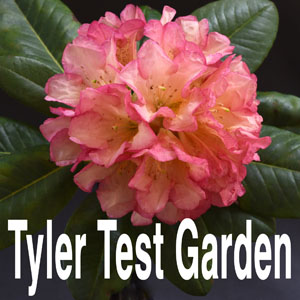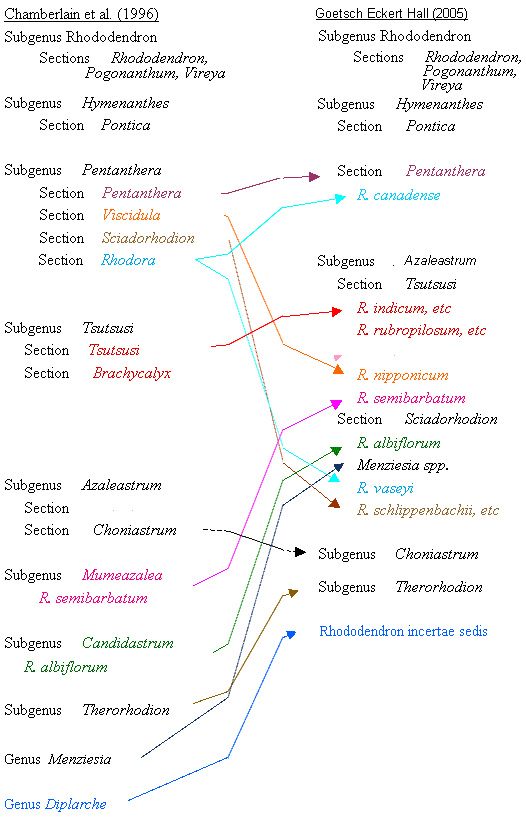
Genus Rhododendron New Classification
Classification
Rhododendrons belong to the Ericaceae or heath family. Other
members of the Ericaceae include the heaths (Erica), and heathers
(Calluna), mountain laurel (Kalmia), lily-of-the-valley shrub
(Pieris), cranberry (Vaccinium), Leucothoe and Andromeda. Almost
all of the heath family make good garden plants.
When Linnaeus created the botanical grouping called genus Rhododendron in 1753, he created a separate genus for Azaleas containing 6 species. In 1796 Salisbury pointed out that Azaleas and Rhododendrons could not be maintained as distinct genera. In 1834, George Don subdivided the genus Rhododendron into 8 sections that were recognized until 2004. Azaleas comprised two of these sections, Subgenus Pentanthera typified by Rhododendron nudiflorum and Subgenus Tsutsusi typified by Rhododendron Tsutsusi.
The extensive collections of Rhododendron in the early 1900's from southern Asia made by Forrest, Rock, Kingdom-Ward, and others stimulated taxonomic work at Edinburgh Botanic Garden and Herbarium under the direction of Bayley Balfour. The horticulturally based classification consists of about 45 series. The artificial classification was intended as a temporary measure, but it became firmly entrenched following the publication of The Species of Rhododendron in 1930 by the Royal Horticultural Society.
This system was designed to cope with the vast quantities of new
plant material received from the Orient, North America, etc. Balfour
intended to revise the temporary system but died before it could
be accomplished.
The Series system does not attempt to classify species under their subgenera and section as proposed in the International Rules of Botanical Nomenclature. Further, it is based largely on cultivated plants rather than Rhododendron found in the wild.
The Eight Subgenera prior to 2004
With many species discovered over several centuries the genus Rhododendron has been subdivided into groups and revised several times. . Up until 2004 the genus was divided into eight subgenera under the taxonomic system of Chamberlain et al. (1996):
- Rhododendron (lepidote rhododendrons and vireyas)
- Hymenanthes (elepidote rhododendrons)
- Pentanthera (elepidote deciduous azaleas)
- Tsutsusi (elepidote evergreen azaleas)
- Azaleastrum (R. ovatum and R. stamineum)
- Candidastrum (R. albiflorum)
- Mumeazalea (R. semibarbatum)
- Therorhodion (R. camtshaticum)
The first four of these subgenera contain all species the entire genus except for five. Of the last four Candidastrum, Mumeazalea and Therorhodion each include only one species (R. albiflorum, R. semibarbatum and R. camtshaticum respectively) while Azaleastrum includes two species (R. ovatum and R. stamineum).
Subgenera Rhododendron and Hymenanthes include the plants that gardeners recognize as the "true" rhododendrons. Some of these, the lepidote rhododendrons, have small scales on their leaves and make up the subgenus Rhododendron. Elepidote rhododendrons, those without leaf scales, form the subgenus Hymenanthes.
Subgenus Pentanthera covered the deciduous azaleas and Tsutsusi covered the evergreen azaleas. Neither of these Subgenus has scales.
A list of all species and their classification is provided in the Genus Rhododendron Taxonomic Tree
The Five Subgenera proposed in 2004
Based upon genetic and chemical data, in 2004, Loretta Goetsch, Andrew Eckert and Benjamin Hall of the University of Washington proposed and in 2005 published a recommendation that the genus Rhododendron be revised and subdivided into five subgenera:
- Hymenanthes (elepidote rhododendrons & deciduous azaleas)
- Azaleastrum (evergreen & deciduous azaleas)
- Choniastrum (R. championae, R. hancockii, R. latoucheae, R. moulmainense, R. stamineum)
- Therorhodion (R. camtschaticum)
- Rhododendron (lepidote rhododendrons & vireyas)

Some of the subgenera are divided into sections, which are further divided into subsections.
For taxa outside of subgenus Rhododendron, this system eliminates three subgenera and two sections that are present in the 1996 taxonomic system of Chamberlain et al.
Section Pentanthera is included within subgenus Hymenanthes.
Sections Sciadorhodion and Viscidula and R. vaseyi (section Rhodora) from the discontinued subgenus Pentanthera are combined with sections Azaleastrum, Tsutsusi and Brachycalyx to form an expanded and revised subgenus Azaleastrum. Sister groups in this subgenus are the sections Tsutsusi (largely evergreen) and Sciadorhodion (entirely deciduous)
Since Choniastrum lacks lepidote scales on the leaves, Goetsch et al. propose that Choniastrum be considered a separate subgenus.
After Dr. Hall presented this work at the ARS National Meeting in 2005, Norman Todd published a paper called "Hall's DNA". In this paper Todd states: "the DNA results obtained by Ben Hall do not support Pentanthera being a subgenus. He proposes that it now become part of Hymenanthes. The genetic differences are not significant enough to warrant sub generic rank. The ranking below Subgenus is Section. Hall proposes that Pentanthera be given a Section ranking. He proposes other changes in the other smaller subgenera ..."
If you understand the basic ideas of genus, subgenus, section and species you will have a better understanding of rhododendron naming conventions. A rhododendron species can be uniquely identified with the genus and species. Hence Rhododendron albiflorum defines a unique species. There may be another genus that uses the name albiflorum since it is Latin for "white flowering". Return to Top
Proposed Genus Rhododendron Taxonomic Tree
This version of a proposed Taxonomic Tree of 785 species is based upon the similar tree published on March 16, 2011 when L. A. Craven showed that genera Diplarche and Menziesia should be nested in genus Rhododendron in section Sciadohodion based upon cladistic analyses of DNA data. [Blumea 56, 2011: 33-35]
The place of the following 2 species from genus Diplarche in genus Rhododendron has not been determined:
Rhododendron chamberlainii, formerly Diplarche multiflora
Rhododendron sophistarum, formerly Diplarche pauciflora
Directory of Contents for Henning's Rhododendron & Azalea Pages
•• Providing Information about the Genus Rhododendron since 1996
••
Articles Published by the American Rhododendron Society
Return to Top

Last Updated:
July 6, 2020
|